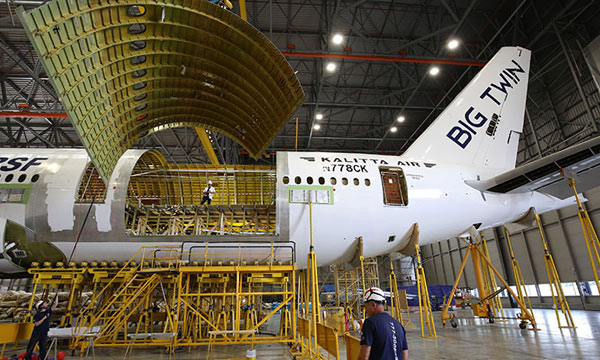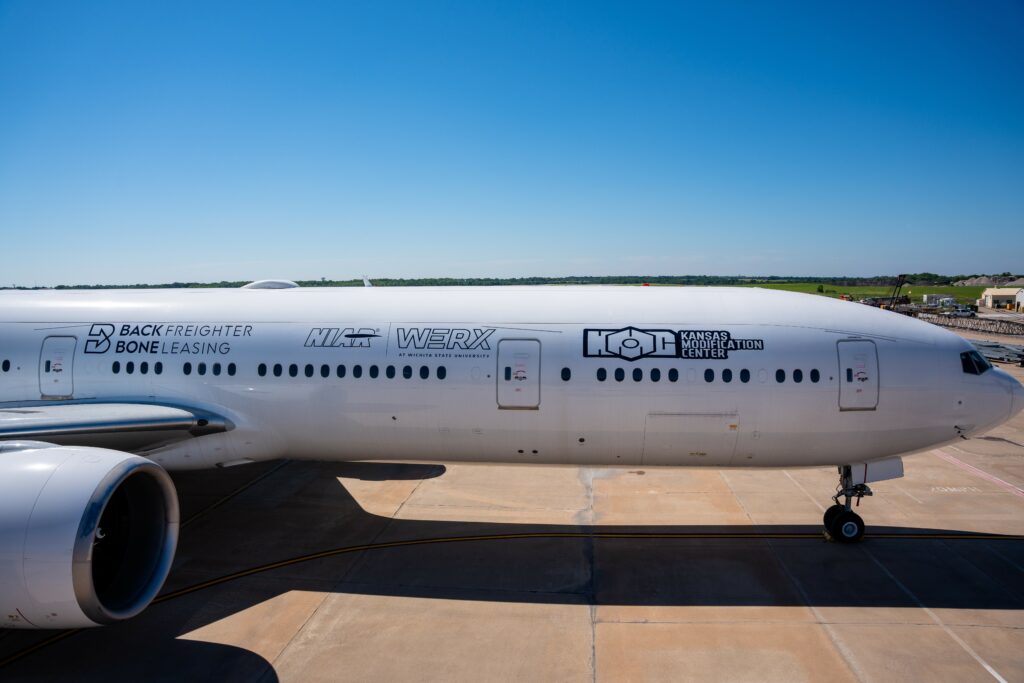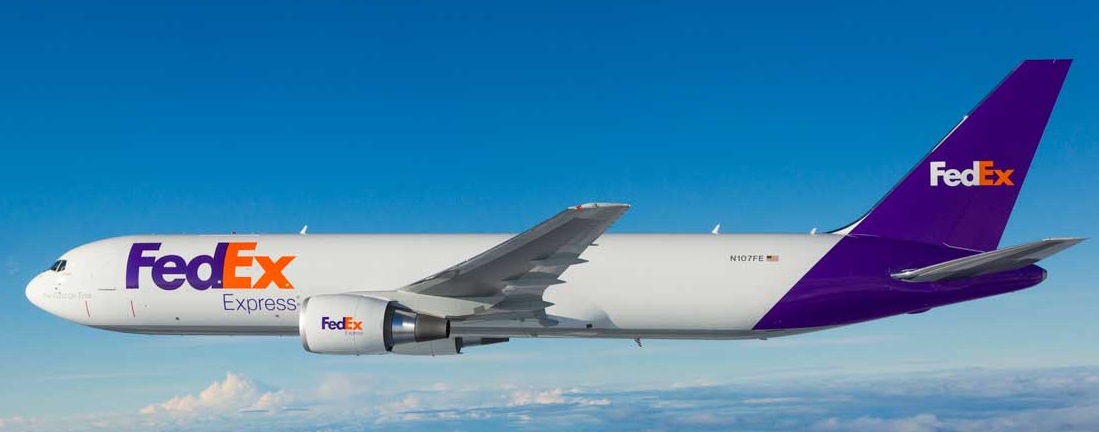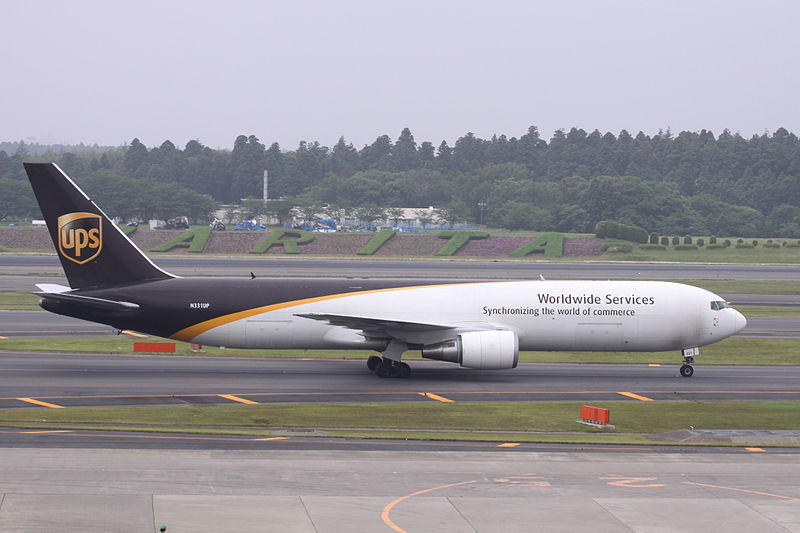Leeham News and Analysis
There's more to real news than a news release.
Re-engining the Boeing 767, Part 2
Subscription required
By Bjorn Fehrm
December 14, 2023, © Leeham News: We are looking at a re-engine of the 767, a move that Boeing is considering to avoid a production stop after 2027. The present 767 engines don’t pass emission regulations introduced by FAA, EASA, and other regulators for production and delivery beyond 2027.
We have described the history of the 767 and the key data of the different variants in last week’s article. Now, we look at what airframe modifications are necessary to house more efficient engines and what consequences these bring.
Summary:
- New, more environmentally friendly engines for the 767 mean changes to the landing gear and structures to house larger and heavier engines.
- For the payload capacity to stay the same a deeper grab in the 767-400 toolbox is necessary than just adopting the landing gear.
KMC’s “low risk” 777 P2F approach struggles to get traction
Subscription Required
By Judson Rollins
August 21, 2023, © Leeham News: Converting Boeing 777-300ER passenger aircraft to freighters has been fraught with challenges. One need only ask longtime P2F provider IAI, whose debut -300ER freighter has flown only once – nearly five months ago. Even Boeing shelved its own P2F plans for lack of a viable business case.
Kansas Modification Center (KMC), launched just two years ago, believes it offers a P2F concept with a smoother path to certification. KMC says its competitive edge is a forward cargo door, requiring less structural reinforcement and thus significant weight savings versus an aft door.
KMC believes it will receive FAA type certification by December 2024, with European regulator EASA expected to follow in early 2025.
LNA received a program briefing from Jorge Della Costa, KMC’s CEO, and Eric Kivett, program manager at contractor National Institute for Aviation Research (NIAR) WERX. NIAR WERX, a unit of Wichita State University, provides engineering and modification services for KMC’s forthcoming 777-300ERCF.
Summary
- Front loading door saves weight but may add loading challenges.
- Lead engineering partner brings prior conversion experience.
- Local partnerships, short supply chain reduce production risk.
- Certification risk mitigated by human factors planning, not modifying software.
- Lack of sales, capital are open questions.
P2F conversion constrained by feedstock, certification issues
Subscription Required
By Judson Rollins
July 3, 2023, © Leeham News: As the supply chain chaos of the past two years finally winds down, the air cargo industry is trying to prepare for future growth.

IAI’s first 777 converted freighter, intended for Kalitta Air, has not flown since its initial testing flight on March 24. Source: IAI.
However, in an ironic twist, the industry’s near-to-intermediate term runway is constrained by some forces that propelled its supernormal profitability during the pandemic and recovery.
Thanks to growth in e-commerce, many industry observers revised their long-term growth forecasts upward. Cargo traffic growth estimates vary widely, from Cirium’s conservative 20-year expectation of 3.0% per year to Boeing’s optimistic call for 4.1% annually through 2042.
This year’s demand environment is less rosy as global trade falters, seaport backlogs have mostly cleared, shippers of high-value industrial goods suffer from microchip and other key commodity shortages, and recovering passenger airline service drives a glut of lower-deck “belly” capacity on most trade lanes.
The International Air Transport Association (IATA) recently said it expects air cargo demand to fall by 3.8% and revenues to contract by one-third for the full year. Cargo volumes were already down 5.3% year-over-year through April, said IATA.
Summary
- Express carriers are most exposed to short-term pain, but long-run prospects are brighter.
- Non-express carriers continue to be hard hit by excess capacity.
- Freighter conversion feedstock supply is tight.
- 777 P2F conversion slowed by possible certification issues; Boeing poised to sell more 777Fs?
Best business; Under-floor Cargo or Dedicated Freighter. Part 4.
Subscription Required
By Bjorn Fehrm
Introduction
July 7, 2022, © Leeham News: What is the best business? To transport cargo below the floor in passenger airliners or dedicated freighter aircraft?
We dug deeper into the cost of flying air freight from Shanghai to Denver last week, forwarded as a below-floor pallet on a passenger jet or via a dedicated freighter.
The cost advantage changed from passenger jet to freighter when we looked deeper into the allocatable cost. Now we finish by analyzing why cargo airlines are consistently more profitable than passenger airlines.
Summary
- Freight airlines generate lower margins from operations than passenger airlines.
- Still, they are more profitable. We explain how.
Best business; Under-floor Cargo or Dedicated Freighter. Part 3.
Subscription Required
By Bjorn Fehrm
Introduction
June 30, 2022, © Leeham News: What is the best business? To transport cargo below the floor in passenger airliners or dedicated freighter aircraft?
We analyzed the cost of flying air freight from Shanghai to Denver last week. It was forwarded as a below-floor pallet or on a dedicated freighter.
We found the allocatable fuel costs were lower when piggybacking on passenger aircraft, but it’s not the whole story. Now we go a level deeper.
Summary
- For fuel costs, the belly cargo alternative was the lower-cost alternative.
- This changed when we added other operational costs.
Best business; Under-floor Cargo or Dedicated Freighter. Part 2.
Subscription Required
By Bjorn Fehrm
Introduction
June 23, 2022, © Leeham News: What is the best business: to transport cargo below the floor in passenger airliners or with dedicated freighter aircraft?
We could see in last week’s article that air freight companies have generally been more profitable over the last decade than passenger airlines. Why?
We continue the analysis by looking at the cost of flying cargo in passenger airliner bellies versus dedicated freighters.
Summary
- At today’s high fuel prices, transporting cargo in a passenger aircraft’s belly is cheaper than on freighters when we do a first-level analysis.
- Does this change when we go deeper?
Best business; Under-floor Cargo or Dedicated Freighter?
Subscription Required
By Bjorn Fehrm
Introduction
June 16, 2022, © Leeham News: What is the best business; to transport cargo below the floor in passenger airliners or dedicated freighter aircraft?
The market clearly says both, as this is the state of affairs. Market economy says a business will find its optimal form, and it’s about fifty-fifty now. But what are the plus and minuses of these two very different ways of transporting cargo, and why do we have the present situation?
We search for answers by looking at the transport fundamentals and comparing costs with revenues.
Summary
- About half of the world’s cargo flies in the bellies of passenger aircraft, and the other half flies on dedicated freighters.
- What are the factors that have created this division, and will it change?
Impact of Russian Airspace Closure for mid-European freight airlines
Subscription Required
By Bjorn Fehrm
Introduction
May 12, 2022, © Leeham News: Last week, we looked at what the closure of Russian airspace would mean for a mid-European airline that flies to Asia destinations like Japan, Korea, or Mainland China.
Air France now flies the routes from East Asia south of Russian airspace instead of over Siberia. The route is longer which increases the operating costs, but with the examples Boeing 777-300ER, there are no restrictions on passenger load factors, and most times, the cargo space can be loaded to the volume limit.
For a freight airline flying similar routes, the added distance impacts payload, as freighters have about 2,000nm less range than their passenger siblings. We check the operating cost and payload impact for mid-European freighter airlines flying from Far-East freighter hubs to West Europe.
Summary
- A freighter airline takes a heavier hit from Russian airspace closure.
- As the extra distance eats into the possible payload, the operating cost per tonne for hubs like Shanghai, Seoul, and Taipei increases more than for the airline’s passenger service.
An A330neo freighter, should it happen?
Subscription Required
By Bjorn Fehrm
Introduction
April 7, 2022, © Leeham News: Last week, we started a discussion on what should be Airbus’ response to a 787 freighter. We have seen in a series of articles that the 787 freighter would beat the present A330 freighter, and the question is, will Airbus leave this segment to Boeing, or will it respond?
We look at what’s involved for Airbus to upgrade the present A330-200F to a neo freighter and what performance it would have compared to a 787 freighter.
Summary
- An upgrade of Airbus’ present A330-200F freighter to a neo variant based on the longer, more capable A330-900 would be a modest project for Airbus. All the special bits needed were developed for the A330-200F.
- The resulting A330-900F would be a competitive freighter, and as all needed parts are in serial production today, it could hit the market before a Boeing 787 freighter.
A Boeing 787 Freighter, Airbus response
Subscription Required
By Vincent Valery
Introduction
March. 31, 2021, © Leeham News: Last week’s article showed that a Boeing 787 freighter based on the -9 variant would be a suitable replacement for the aging 767-300F.
Should Boeing proceed with the aircraft, expect Airbus to launch a competing airplane, it not launch it before the American OEM.
The A330-200F recorded 38 sales as a factory freighter, a disappointing tally. Which aircraft variant could Airbus use as a baseline to develop a more successful 787F competitor?
Summary
- A nuanced view on 767-300F and A330-200F factory sales;
- Need for suitable older-generation aircraft replacement;
- Limitations of A330 P2Fs;
- A potential candidate.







